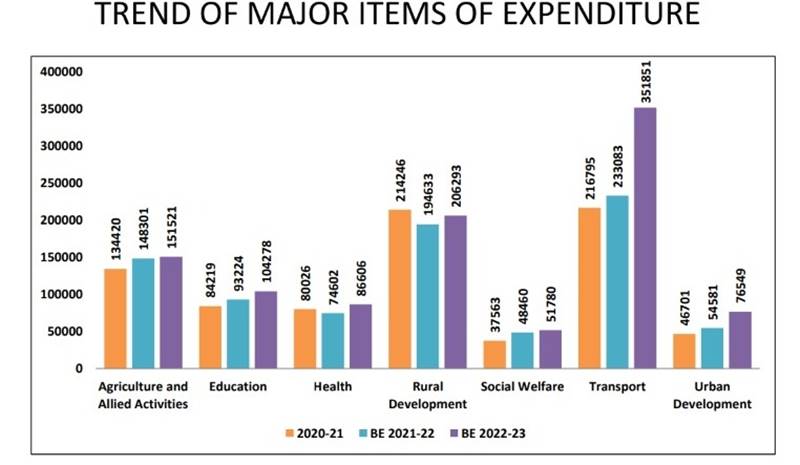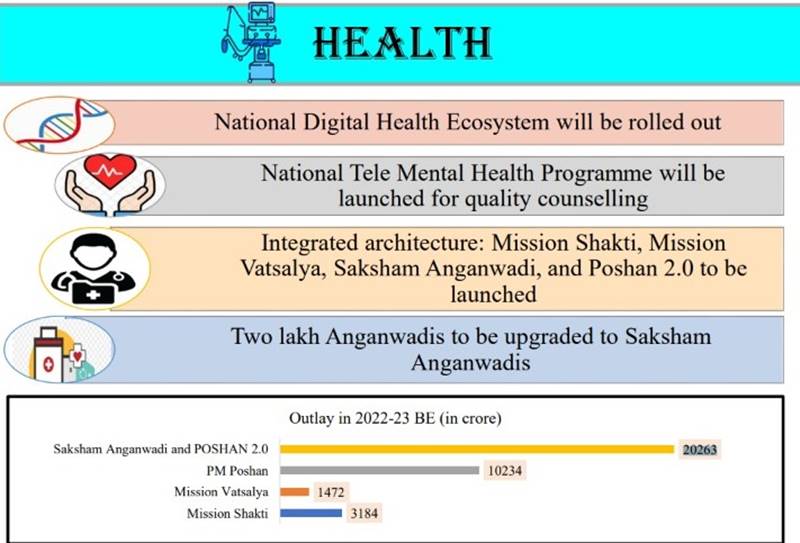Health sector gets Rs 86,606 crore in Budget 2022; public health experts say “not enough”
The Budget Estimate 2022-23 has allocated Rs 86,606 crore to the health sector, which is a “negligible” increase as compared to the Revised Estimate of Rs 85,915 crore for FY 2021-22. Prioritisation of health is missing in this year’s budget despite the country facing the third wave of the pandemic, say public health experts.


On February 1 morning, Finance Minister Nirmala Sitharaman presented the Union Budget 2022-23 in the parliament. Surprisingly, there was little mention of funds allocation to health and nutrition schemes in her budget speech.
Released a little later in the day, the Union Budget 2022 document shows the Budget Estimate 2022-23 for the health sector stands at Rs 86,606 crore. This is an increase of 16 per cent from Rs 74,602 crore Budget Estimates in the financial year of 2021-222.
Interestingly, the allocations for the current financial year is a “negligible” increase as compared to the Revised Estimate of Rs 85,915 crore for FY 2021-22. Budget estimates are budget allocations announced at the beginning of each financial year. Revised Estimate is mid-year review of possible expenditure in a financial year.
“The current allocation is almost equal to the revised estimates of last year. This government has undermined the health and nutrition of the country. This Budget is for corporations and companies. The government has turned a complete blind eye on the issues of health and nutrition,” Rajasthan-based Chhaya Pachauli, a public health expert working with Jan Swasthya Abhiyan, told Gaon Connection.
Also Read: If children could vote: In poll-bound UP, high malnourishment but 66% POSHAN funds unutilised
The Economic Survey 2022 shows India spent 2.1 per cent of its GDP on health in the previous financial year 2021-22, up from 1.8 per cent in 2020-21. The Indian government is planning to increase public health spending to 2.5 per cent of the country’s GDP by 2025, as per the National Health Policy 2017 report.
Low budget for crucial health schemes
The Budget Estimates for National Health Mission have been increased from Rs 37,130 crore in 2021-22 to Rs 37,800 crore in 2022-23 — a mere increase of one per cent. The revised estimates for 2021-22 were Rs 34,947 crores, less than the 2022-23 Budget Estimates.
“This would put the burden of financing the programme on the states. While the relatively developed states have greater resources to invest in the health needs of the population, the lack of support from the Centre will put the less developed states at a significant disadvantage,” Poonam Muttreja, a public health expert was quoted in a press statement issued by Population Foundation of India today.
In terms of healthcare budget, India ranks 179 out of 189 countries in prioritisation accorded to health in its government budgets, she informed. “The 2022-23 budget does not prioritise health and the problem of inequality,” the public health expert added.
The National Health Mission (NHM) has been the government of India’s flagship health programme since 2005 and has played a crucial role in improving health outcomes in the country.

Also Read: Anaemia in children on the rise in India; 72.7% under-5 kids in rural Madhya Pradesh anaemic
This budget could have done much more to bridge the widening gap between the rich and poor in the country, said Muttreja. “Last year’s budget signalled the importance of health and well-being by terming it as the first of six pillars. It also focussed on strengthening three key areas, namely preventive, curative and overall well-being. However, a similar prioritisation of health is missing in this year’s budget, especially as we are in the midst of a third wave of the pandemic,” she added.
Sufficient funds for nutrition schemes?
Union Finance Minister Sitharaman also announced to upgrade 200,000 anganwadi centres across the country. “Our government has comprehensively revamped schemes of the Ministry of Women and Child Development such as Mission Shakti, Mission Vatsalya, Saksham Anganwadi and Poshan 2.0,” she said.
The outlay in 2022-23 Budget Estimates for Saksham anganwadi and POSHAN 2.0 is Rs 20,263 crores, PM Poshan is Rs 10,234 crores, Mission Vatsalya is Rs 1,472 crores, and Mission Shakti is for Rs 3,184 crores.
For Saksham anganwadi and POSHAN 2.0 (Umbrella ICDS – anganwadi services, poshan abhiyan, scheme for adolescent girls) Budget estimate is Rs 20,263 for financial year 2022-23, a marginal increase from FY 2021-22 Budget Estimate of Rs 20,105 crores.
“Saksham anganwadis are a new generation of anganwadis that have better infrastructure and audio-visual aids, powered by clean energy and providing an improved environment for early child development. Two lakh anganwadis will be upgraded under the Scheme,” she added.
“The government is focusing on digitisation but does not consider digital divide in urban and rural areas. In villages, anganwadis lack basic infrastructure including water, toilets,” said Pachauli.
Also Read: POSHAN on wheels, nutri-kits and mobile anganwadis to tackle malnutrition in Assam
Under anganwadi services, a package of six services: supplementary nutrition; pre-school non-formal education; nutrition & health education; immunization; health check-up; and referral services, has been provided to all eligible beneficiaries, including children in the age group of 0-6 years, pregnant women and lactating mothers through the platform of anganwadi centres across the country.

“If the budget outlay remains same but the share of salary and pension expenses of the department increases over the same period, the core programme of supplementary nutrition will be affected,” Odisha-based Sameet Panda, Right to Food Campaign, told Gaon Connection. “Because salary and pension will not decrease, the government cannot compromise there, this would result in lesser budget allocation to the largest supplementary nutrition programme in turn compromising the nutrition component of the programme.
In India, 158 million kids are registered with the 1.36 million functional anganwadi centres spread across the country (as of June 2018).
“Schemes mentioned in the speech, such as Saksham anganwadi, already exist and have seen almost no increase in their budget over the previous financial year. If we take inflation into account, these budgets have declined,” Muttreja, executive director of Population Foundation of India, was quoted.
“The Finance Minister also did not mention any announcements around how the ongoing nutrition crisis will be tackled, despite the rising levels of anaemia in the country as indicated by the recently released fifth round of the National Family Health Survey (NFHS),” said Muttreja.
As per the NFHS5 (2019-21), 57 per cent of women aged 15-49 years in India are anaemic. This has increased from 2015-16 where according to NFHS-4, 53.1 per cent women were found to be anaemic. In the same period, anaemic children have increased from 58.6 per cent in NFHS4 to 67.1 per cent in NFHS5.
Mid-Day Meal funds reduced?
Meanwhile, the allocations for the National Programme of Mid-Day Meal in schools now renamed as Pradhan Mantri Poshan Shakti Nirman has declined by 11 per cent from Rs 11,500 crores in 2021-22 to Rs 10,233.75 crores in 2022-23.
“Schools are closed and mid day meals are shut. Since the two years of pandemic, nutrition schemes for children are already in crisis, the budget should have been increased in this scenario. There were demands to add breakfast in the mid day meal. Additional five thousand crores was demanded. The allocations should have been Rs 15-17,000 crores,” Panda said.
Digital tools and digital divide
While presenting the Budget 2022, Union Finance Minister Nirmala Sitharaman announced the launch of a national tele-mental health programme for mental health counselling. Sitharaman pointed out that the COVID19 pandemic has accentuated mental health problems in people of all ages.
“To better the access to quality mental health counseling and care services, a National Tele Mental Health programme will be launched. This will include a network of 23 tele-mental health centres of excellence with Nimhans being the nodal centre and IIIT Bangalore providing technology support,” announced Sitharaman.
Interestingly there is no mention for Budget Estimates for India’s COVID19 Emergency Response and Health System Preparedness Package in FY 20212-22. The Union Budget 2022 only documented Rs 12,359 as revised estimates for FY 2021-22.
The Union Finance Minister has also announced to roll out an open platform for the National Digital Health Ecosystem. It will consist of digital registries of health providers and health facilities, unique health identity and universal access to health facilities.

